The bottom tail formation is a trend reversal pattern that comes at the end of a down move. Below is the setup for the bottom tail pattern:
- There is a downtrend in progress
- Select two popular time frames that are close together (i.e. 1-min & 5-min or 5-min &15-min)
- Identify a bottom tail candle on both time frames
- You will want to enter the trade on the break of the high of the bottom tail candle
- Enter your stop below the low of the bottom tail candle
A bottom tail is a candlestick that has a long wick and small body. If you were to dissect the body of the candle there was increased selling pressure which resulted in the long wick, followed by a strong rally that left the stock closing very close to where it opened. The bottom tail will reveal itself after an established downtrend and is one of the first examples that the bears are losing control and the trend is shifting to a more neutral state. Below is an image of a bottom tail.
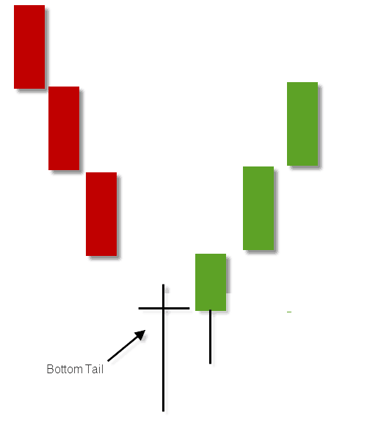 For those of you reading this article that do not have a lot of experience with trading candlestick formations, these formations are another version of a technical indicator. Some in the industry will lead you to believe that simply identifying the key patterns will lead to instant wealth. Instead of looking to candlesticks as the magic bullet, these formations are great when combined with other confirming signs. This rule of looking for confirmation in other indicators is always a great idea to validate your beliefs.
For those of you reading this article that do not have a lot of experience with trading candlestick formations, these formations are another version of a technical indicator. Some in the industry will lead you to believe that simply identifying the key patterns will lead to instant wealth. Instead of looking to candlesticks as the magic bullet, these formations are great when combined with other confirming signs. This rule of looking for confirmation in other indicators is always a great idea to validate your beliefs.
Specifically for the bottom tail formation we are going to use the price action on multiple time frames to confirm a reversal in trend. The power of using multiple time frames is on an intra-day basis when traders on different time frames see the same thing, this confluence can result in great trend reversal opportunities. Think about it. If both traders on a 5-minute and 15-minute bar both see a buy signal, you now have more participants taking action at the same price level. This will increase the amount of activity which is required to generate a reversal of trend.
For the analysis covered in this article we will use the 5-minute and 15-minute charts. When comparing multiple time frames you will want to focus on (1) the most popular time frames and (2) of these time frames the ones that are closest to each other. For example you would want to pair the 15-minute with the 30-minute, or the 1-minute with the 5-minute. The expectations for gains should be in direct proportion to the time frame you have selected. It’s not good form to expect the same level of price swings on a 1-minute chart as you would on a 60-minute.
Bottom Tail Example – Goldman Sachs
In this first example we will be looking at a bottom tail formation for Goldman Sachs from 8/10/2012. Can you identify the bottom tail pattern in both the 5-minute and 15-minute charts below?
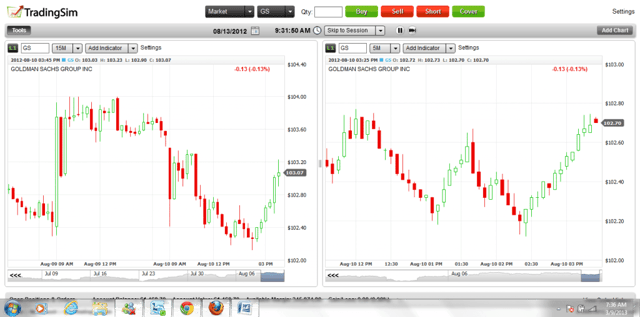
Did you pick the right tails? So for the 15-minute bar the bottom tail showed up on the print of the 2:15 candle. For the 5-minute bar the bottom tail revealed itself on the print of the 2:20 candle.
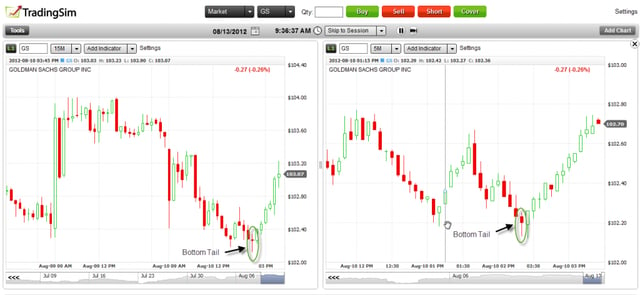
Notice how both candles have longer wicks and smaller bodies. Also, do you see the display of downward pressure from the number of red candles preceding these lows?
Now comes the fun part. Where do you think you should enter the trade?
For the more aggressive trader you will enter a break of the bottom tail’s high on the 5-minute bar. The reason being the high from the 15-minute bar is likely to be greater than that of the 5-minute bar because it is on a longer time frame. For those of you that want additional confirmation the trend has a greater chance of reversing you will want to enter on a break of the bottom tail’s high on the 15-minute bar.
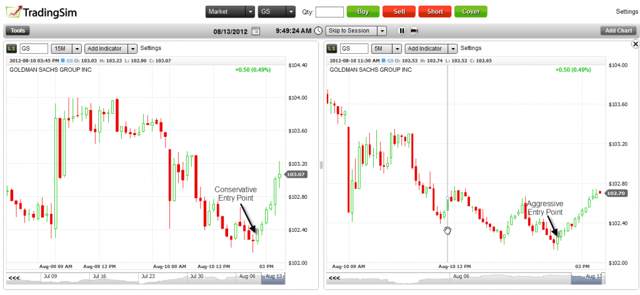
Stops
In terms of stops you will want to place your market order below the low of the bottom tail bar. Another option is to place your buy order on the 15-minute scale and your stop market order on the low of the 5-minute bottom tail. This way you can be slow a.k.a conservative to enter the trade, but quick to kill the position if it goes against you.
Profit Targets
For profit targets you will want to either sell into the strength or use a moving average to exit your trade. For example, if there is a gap above that the stock is now going back to fill and you see climatic volume coming in you will want to exit at that point. Another option would be to apply a moving average (i.e. 10, 20, etc.) to the chart and then close out your position once the stock closes beneath the average.
Pros of the Bottom Tail Day Trading Strategy
The bottom tail buy strategy combines both candlestick patterns with the concept of time – traders on two different time frames. The entry points and exit points are straight forward. You can apply this strategy to any security and you can use it on multiple time frames
Cons of the Bottom Tail Day Trading strategy
It is tough to find a bottom tail on both the 5-minute and 15-minute bars unless you have a real-time stock screener. Since the stock is trading in real-time and you only have minutes to identify the trade, you have to quickly scan the market for bottom tails on both time frames simultaneously. This would be a simple task if you were looking at daily/weekly charts, but is far more challenging an an intra-day basis.

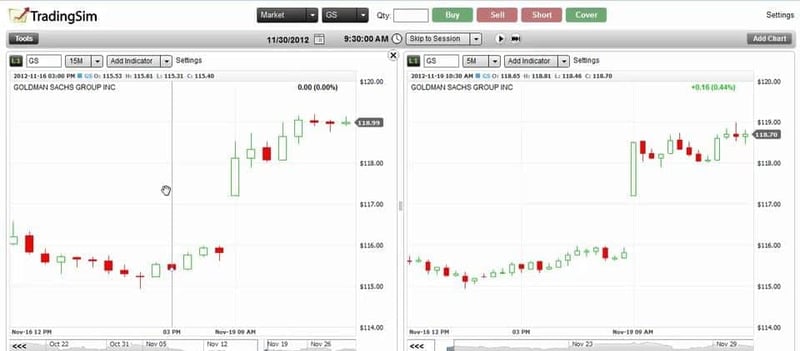









 Awesome Day Trading Strategies
Awesome Day Trading Strategies 
